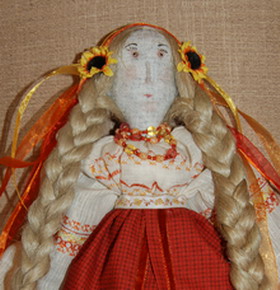 This doll have Ukrainian folk costumes that are entirely made and
embroidered. His name is Marichka.
Dolls can be more than toys — they can reflect the national traditions, national spirit and cultural continuity.
Each doll who create master has wears a traditional national dress which is typical for one particular region of Ukraine and reflects its historical background.
History ukrainian traditional doll. Dolls and toys must have come into being at the earliest stages of civilization. They were made of clay, rags, threads, hay, grass, and of many other things. Dolls were given basically human shapes which hinted at the human figure rather than depicted it faithfully. In many cases, so many lengths of threads, for example, were bunched together, folded at the centre, and a thread was tied around the bunch, separating “the head” from “the body.” In more sophisticated dolls, the face was painted but again no attempt was made to create a convincingly “realistic” image.
 In Ukraine, dolls have been a feature of everyday life since time immemorial. A doll in a peasant’s house was looked upon as a sort of Berehynya — Protectress of the household. When a woman was given a doll as a present it was an encouragement for her to have a child. This tradition has survived well into our days — quite often you can see dolls fixed to the front of the hoods of festively decorated cars that carry brides and bridegrooms to marriage registration ceremonies, to churches or to wedding receptions.
In creating a doll there is a divine element present like in any act of creation but in case of dolls, we create something “in our image, after our likeness.” Making a doll reminds one of the Biblical story of God creating man.
Foto. A little traditional doll. No paintig fase. No sweing.
| 